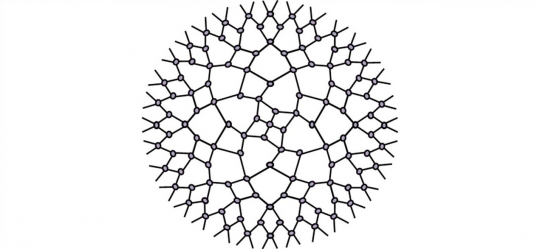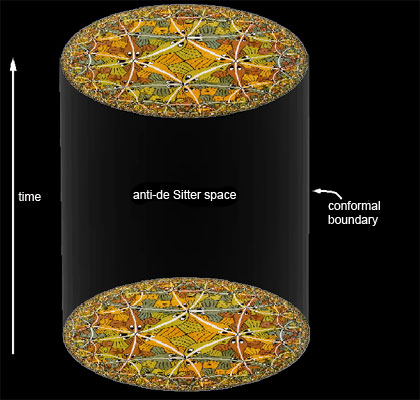Quantizing gravity is an important goal of contemporary physics, but after decades of effort it’s proven to be an extremely tough nut to crack. So it’s worth considering a very slight shift of emphasis. What if the right strategy is not “finding the right theory of gravity and quantizing it,” but “finding a quantum theory out of which gravity emerges”?
That’s one way of thinking about a new and exciting approach to the problem known as “tensor networks” or the “AdS/MERA correspondence.” If you want to have the background and basic ideas presented in a digestible way, the talented Jennifer Ouellette has just published an article at Quanta that lays it all out. If you want to dive right into some of the nitty-gritty, my young and energetic collaborators and I have a new paper out:
Consistency Conditions for an AdS/MERA Correspondence
Ning Bao, ChunJun Cao, Sean M. Carroll, Aidan Chatwin-Davies, Nicholas Hunter-Jones, Jason Pollack, Grant N. RemmenThe Multi-scale Entanglement Renormalization Ansatz (MERA) is a tensor network that provides an efficient way of variationally estimating the ground state of a critical quantum system. The network geometry resembles a discretization of spatial slices of an AdS spacetime and “geodesics” in the MERA reproduce the Ryu-Takayanagi formula for the entanglement entropy of a boundary region in terms of bulk properties. It has therefore been suggested that there could be an AdS/MERA correspondence, relating states in the Hilbert space of the boundary quantum system to ones defined on the bulk lattice. Here we investigate this proposal and derive necessary conditions for it to apply, using geometric features and entropy inequalities that we expect to hold in the bulk. We show that, perhaps unsurprisingly, the MERA lattice can only describe physics on length scales larger than the AdS radius. Further, using the covariant entropy bound in the bulk, we show that there are no conventional MERA parameters that completely reproduce bulk physics even on super-AdS scales. We suggest modifications or generalizations of this kind of tensor network that may be able to provide a more robust correspondence.
(And we’re not the only Caltech-flavored group to be thinking about this stuff.)
Between the Quanta article and our paper you should basically be covered, but let me give the basic idea. It started when quantum-information theorists interested in condensed-matter physics, in particular Giufre Vidal and Glen Evenbly, were looking for ways to find the quantum ground state (the wave function with lowest possible energy) of toy-model systems of spins (qubits) arranged on a line. A simple problem, but one that is very hard to solve, even on a computer — Hilbert space is just too big to efficiently search through it. So they turned to the idea of a “tensor network.”
A tensor network is a way of building up a complicated, highly-entangled state of many particles, by starting with a simple initial state. The particular kind of network that Vidal and Evenbly became interested in is called the MERA, for Multiscale Entanglement Renormalization Ansatz (see for example). Details can be found in the links above; what matters here is that the MERA takes the form of a lattice that looks a bit like this.
Our initial simple starting point is actually at the center of this diagram. The various links represent tensors acting on that initial state to make something increasingly more complicated, culminating in the many-body state at the circular boundary of the picture.
Here’s the thing: none of this had anything to do with gravity. It was a just a cute calculational trick to find quantum states of interacting electron spins. But this kind of picture can’t help but remind certain theoretical physicists of a very famous kind of spacetime: Anti-de Sitter space (AdS), the maximally symmetric solution to Einstein’s equation in the presence of a negative cosmological constant. (Or at least the “spatial” part thereof, which is simply a hyperbolic plane.)
Of course, someone has to be the first to actually do the noticing, and in this case it was a young physicist named Brian Swingle. Brian is a condensed-matter physicist himself, but he was intellectually curious enough to take courses on string theory as a grad student. There he learned that string theorists love AdS — it’s the natural home of Maldacena’s celebrated gauge/gravity duality, with a gauge theory living on the flat-space “boundary” and gravity lurking in the AdS “bulk.” Swingle wondered whether the superficial similarity between the MERA tensor network and AdS geometry wasn’t actually a sign of something deeper — an AdS/MERA correspondence?
And the answer is — maybe! Some of the features of AdS gravity are certainly captured by the MERA, so the whole thing kind of smells right. But, as we say in the paper above with the expansive list of authors, it doesn’t all just fall together right away. Some things you would like to be true in AdS don’t happen automatically in the MERA interpretation. Which isn’t a deal-killer — it’s just a sign that we have to, at the very least, work a bit harder. Perhaps there’s a generalization of the simple MERA that must be considered, or a slightly more subtle version of the purported correspondence.
The possibility is well worth pursuing. As amazing (and thoroughly checked) as the traditional AdS/CFT correspondence is, there are still questions about it that we haven’t satisfactorily answered. The tensor networks, on the other hand, are extremely concrete, well-defined objects, for which you should in principle be able to answer any question you might have. Perhaps more intriguingly, the idea of “string theory” never really enters the game. The “bulk” where gravity lives emerges directly from a set of interacting spins, in a context where the original investigators weren’t thinking about gravity at all. The starting point doesn’t even necessarily have anything to do with “spacetime,” and certainly not with the dynamics of spacetime geometry. So I certainly hope that people remain excited and keep thinking in this direction — it would be revolutionary if you could build a complete theory of quantum gravity directly from some interacting qubits.


Ray (breakfast discussions), I’m so envious. But in another corner of the universe there is a couple identical to me and my wife. Only wife2 has an interest in science.
Pingback: Futureseek Daily Link Review; 11 May 2015 | Futureseek Link Digest
Allan I sympathize and am also envious. My wife, wonderful in many ways, does show just a little interest in physics at breakfast. It seems her interest is mostly concerned with order in the immediate macro world and my part in increasing it.
The Milky Way is moving through and displacing the mass that fills ’empty’ space.
The state of displacement of the mass which fills ’empty’ space is curved spacetime.
Simon, my wife is away for a couple of weeks. The 2nd law of thermodynamics is taking it’s toll on my immediate surroundings. Much energy will need to be expended before her return.
The Milky Way moves through and displaces the ‘dark mass’.
The state of displacement of the dark mass is curved spacetime.
Pingback: Paul Steinhardt’s remorse, Popperianism and Beauty-Contest | The Great Vindications
Pingback: Shtetl-Optimized » Blog Archive » Five announcements
I liked your book on Gravity very much. Thank you for writing it and sharing it.
Pingback: Quantum Poincaré circuits – Quantum Bot
Pingback: What are good science related websites other than this?
Dear Friend
Present day science is still not developed to distinguish between matter/energy content & conscious reality. These are two different realities of universe in which former has interchangebility with respect to time but latter remains constant irrespective of time.
There is nothing like empty space in this universe but it is filled with extremely fine,non divisible, continuous & uniform reality which is conscious in nature. It has self contained intelligence, self driven in nature and full of its own energy. Modern science calls it a dark energy reality.
As the matter/energy content of universe is dipped inside the ocean of conscious reality, which is continuously interacting and dominating upon the former.It has full authority on expansion and contaction phase of universe.The state of universe is an outcome of interaction of these two realities which is existing all the time to eternity.
But present day science understands that there is only single reality which is found in discreet quantum fields existing in the space. Now there is hard to define their coherant actions to decide for beginning and subsequent expansion of universe against the force of gravity. Hence there is no convincing theory for quantum gravity.
The concept of space time emerges out when singularity is stretched apart by dark energy reality. Subsequently universe expands at the tremendous rate and symmetry breaks down in four fundamental forces.
Ajay
Pingback: Does Spacetime Emerge From Quantum Information? by Seen Carroll | ThoughtShelf
https://www.youtube.com/watch?v=OBPpRqxY8Uw
“ER = EPR”, or “What’s Behind the Horizons of Black Holes?” Part 1/2
Leonard Susskind seems to describe something similar. Very interesting.
We have all heard the same theory of Space-Time being warped to travel through time and other universes, since Space-Time can be warped which means crunching it smaller, then why cant it be “expanded” or “zoomed” which would create artificial space and time causing things to slow down, this is better than us trying to achieve the speed of light..
Pingback: Holography and the MERA | Quantum Frontiers
normal matter= darkmatter^2 * darkenergy
normal matter=.049
dark matter=.268
dark energy=.683